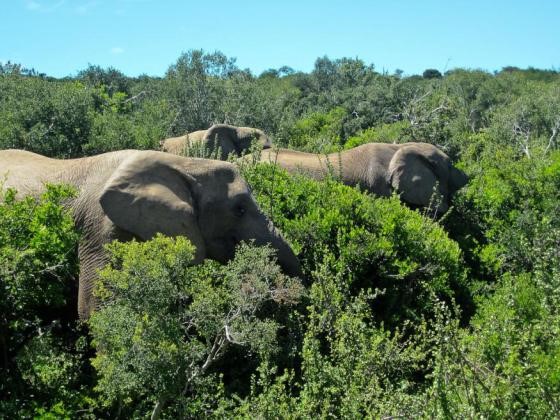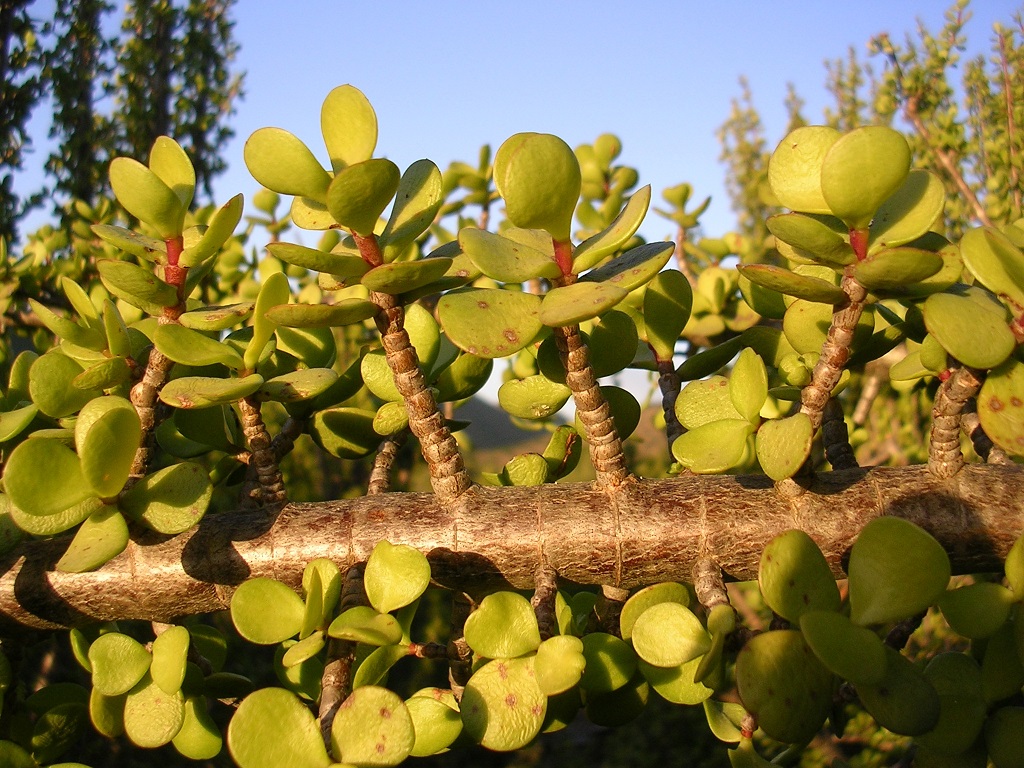Rolling back the desert
The Kuzuko Thicket Restoration Project will restore more than 5000 hectares of degraded land in the Eastern Cape of South Africa. Teams from local communities will be trained to plant cuttings of the indigenous thicket tree commonly known as spekboom. Healthy spekboom thicket creates a favoured habitat for animals and insects. The restored thicket will also capture millions of tons of carbon dioxide over the project’s lifespan. Learn more about the KuzukoThicket Restoration Project and spekboom by watching the video.



In partnership with


About The Kuzuko Thicket Restoration Project
The Kuzuko Thicket Restoration Project will restore damaged ecosystems, benefit poor communities through job creation and capture carbon from the atmosphere. It will do so by restoring more than 5000 hectares of degraded land in the Kuzuko Reserve in the Eastern Cape of South Africa.
This project is the flagship initiative of Spekboom Trading; a partnership between Inqo Investments and AfriCarbon. Inqo Investments specialises in addressing poverty and social needs and AfriCarbon facilitates investments in restoration of ecosystems through community participation.
The spekboom plant is the inspiration behind the company’s name. This succulent tree briskly fixes carbon from the air, storing it in its leaves, stems and roots. Some of this carbon is transferred into soils from fallen leaves and old roots. This stored carbon can be sold for carbon credits, which are bought by companies to offset their carbon emissions. Once established, spekboom thicket forms the base for a healthy diverse ecosystem.
If you are interested in purchasing carbon credits produced by the Kuzuko Thicket Restoration Project, please contact us directly.
Advisory Board
Dr Anthony Mills
Dr Anthony Mills studied at several universities – including the University of Cambridge, the University of Cape Town, Trent University in Canada, and Stellenbosch University – and has a multi-disciplinary training in the fields of environment and development, soil science, ecology. Anthony has researched the effects of land use on carbon stocks in several ecosystems in South Africa and has published extensively on this topic in peer-reviewed scientific journals. He is a member of staff in the Department of Soil Science, Stellenbosch University. Anthony is also CEO of C4 EcoSolutions, a business he established in 2006, which today comprises a team of 14 climate change adaptation professionals. The focus of C4 EcoSolutions’ work is designing and implementing ecosystem restoration projects in developing countries. The main clients of the business are the United Nations Environment Programme, the United Nations Development Program, the South African government’s Department of Environmental Affairs, the Food and Agriculture Organisation of the United Nations, and the International Finance Corporation. C4 EcoSolutions works in more than 40 countries across Africa, the Pacific, the Caribbean and Asia.
David Louw
David Louw is a Chartered Accountant (SA) with wide experience in the Hospitality, Media, Agriculture (wine and game) Industries. Previously Director and Shareholder of the Protea Hotel Group and Radio K-FM (CEO). He is currently on the board of a number of privately owned businesses operating in game farming, hospitality and wine farming industries.
Directors
Dr Anthony Mills
See above for more info.
Christopher John Bertie
Chris is a chartered accountant (SA), a former partner at Ernst & Young and MD of Halcyon Hotels (a company that operated hotels and restaurants in the Western Cape). He is currently an independent consultant and in some cases a non-executive director, working with a selected client base in the hospitality and wine industries.
Benefits
Community
Kuzuko Thicket Restoration Project will provide work for more than 150 people in an area of South Africa where unemployment approaches 50%. Planters will not only learn skills that are directly applicable to the project’s work, but also additional valuable skills related to:
- first aid and health & safety;
- fire awareness and firefighting;
- personal and sexual health; and
- personal finance.
Conservation
The conservation benefits of the project are significant. When spekboom blankets the landscape, biodiversity increases dramatically. In addition to a wide range of mammals, birds and insects, the project will help to conserve the black rhinoceros and African elephant, which have been placed on the IUCN Red List of Critically Endangered species.
Once the spekboom cuttings start growing, new topsoil is generated as the trees shed their leaves and as the earthworms in these ecosystems return to eat the leaf litter. As the topsoils regenerate, other plants move back into the ecosystem and animals return.
Thicket restoration will also stop the extreme erosion of soil into rivers and dams. In the degraded desert landscape, rain falls on a hard brown surface and runs off quickly. In restored spekboom thicket, rainwater soaks into dark rich soils and flows slowly into deep aquifers that then release water into streams and rivers. Even in the dry season, the rivers will flow. The restored landscape acts like a green sponge rather than a brown concrete-like slab. Consequently, the overall functioning of water catchments will be improved.
Capturing Carbon
The Kuzuko Thicket Restoration Project will put a new arrow in the quiver of carbon credits across the world. At present carbon credits are largely associated with either renewable energy projects or projects to conserve existing forests. The Kuzuko Thicket Restoration Project differs fundamentally from all of these projects. Instead of preventing further emissions of carbon into the atmosphere, it captures carbon while healing ecosystems that have already been badly damaged.
Spekboom is a succulent tree that briskly fixes carbon from the air, storing it in its leaves, stems and roots. Some of this carbon is transferred into soils from fallen leaves and old roots. This stored carbon can be sold as carbon credits, which are bought by companies to offset their carbon emissions. Once established, spekboom thicket forms the base for a healthy diverse ecosystem.
The Kuzuko Thicket Restoration Project has achieved the toughest verification standards possible – obtaining both Verified Carbon Standard (VCS) and Carbon, Community and Biodiversity Alliance (CCBA) Gold status.
To learn more about carbon credits and carbon trading, please visit the AfriCarbon website.
If you are interested in purchasing carbon credits produced by the Kuzuko Thicket Restoration Project, please contact us directly.
Resources
Brochures & Reports
- Mills, A.J., Blignaut, J.N., Cowling, R.M., Knipe, A., Marais, C., Marais, S., Pierce, S.M., Powell, M.J., Sigwela, A.M. & Skowno, A. 2010. Investing in sustainability. Restoring degraded thicket, creating jobs, capturing carbon and earning green credit. Published by Climate Action Partnership, Cape Town, and Wilderness Foundation, Port Elizabeth. Download Report
- Nocita, M., Bachmann, M., Müller, A., Kooistra, L., Powell, M., Mills, A. & Weel, S. Soil spectroscopy as a tool to assess organic carbon, iron oxides and clay content in the Subtropical Thicket Biome of Eastern Cape Province of South Africa. In: Proceedings of the 6th EARSeL (European Association of Remote Sensing Laboratories) SIG Imaging Spectroscopy Workshop, Tel Aviv, 2009.
- Marais, C., Cowling, R.M., Powell, M. & Mills, A. 2009. Establishing the platform for a carbon sequestration marketing South Africa: The Working for Woodlands Subtropical Thicket Restoration Programme. XIII World Forestry Congress, Buenos Aires.
- Van den Broeck, D., Weel, S., Boogerd, C., Trollope, W.S.W., Dube, S. Of a vegetation monitoring programme for the Thicket communities in the Great Fish River Reserve. South African Wildlife Management Association Conference 2008. Eastern Cape Parks.
- Mills, A.J., O’Connor, T.G., Bosenberg, D.W., Donaldson, J., Lechmere-Oertel, R.G., Fey, M.V. & Sigwela, A. 2003. Farming for carbon credits: implications for land use decisions in South African rangelands. VII International Rangeland Congress, Durban, South Africa.
- Lloyd, J.W., van den Berg, E.C. & Palmer, A.R. 2002. Patterns of transformation and degradation in the Thicket Biome, South Africa. Terrestrial Ecology Research Unit, University of Port Elizabeth, Port Elizabeth. Report No. 39.
- Turpie, J.K., Lechemer-Oertel, R.G., Sigwela, A., Antrobus, G., Donaldson, J., Robertson, H., Skowno, A., Knight, A., Koelle, B., Mills, A.J., Kerley, G., Leiman, A. & van Zyl, H. 2003. The ecological and economic implications of conversion to game farming in the xeric succulent thicket of the Eastern Cape, South Africa. In: Turpie JK (ed.) An ecological-economic appraisal of conservation on commercial farmland in four areas of South Africa. Conservation Farming Report, National Botanical Institute, Cape Town.
- Hobson, F.O., Stuart-Hill, G.C. & Swart, M.L. 1993. Establishment of spekboom: unpublished preliminary results. Dohne Research Station, Stutterheim.
- Midgley, J.J. 1991. Valley Bushveld dynamics and tree euphorbias. In: Zacharias, P.J.K., Stuart-Hill, G.C. & Midgley, J. (eds.) Proceedings of the first Valley Bushveld/Subtropical Thicket Symposium, 8-9. Special Publication, Grassland Society of Southern Africa.
- Stuart-Hill, G.C. 1989. Succulent valley bushveld. In: Danckwerts, J. & Teague, W.R. (eds.) Veld Management in the Eastern Cape. 165-174. Department of Agriculture and Water Supply.
Publications
Journal Articles and Book Chapters
- Mills, A.J., Cowling, R.M. (2014). How Fast Can Carbon Be Sequestered When Restoring Degraded Subtropical Thicket? Restoration Ecology. 22: 571-573
- Mills, A.J., Spear, D., Ndhlovu, T., Knight, M.H., Pienke, D.M., Hofmeyr, S. & Cowling, R.M. (2014). Biomass of large herbivores in South African subtropical thicket. African Journal of Ecology.
- Van Luijk,G., R.M. Cowling, Riksen, M.J.P.M., & Glenday, J. 2013. Hydrological implications of desertification: Degradation of South African semi-arid subtropical thicket. Journal of Arid Environments. 91: 14-21
- Van der Vyver, M.L., Cowling, R.M, Mills, A.J. & Difford, M. 2012. Spontaneous return of biodiversity in restored subtropical thicket: Portulacaria afra as an ecosystem engineer. Restoration Ecology. 21: 736–744
- Van der Vyver, M.L., Cowling, R.M., Campbell, E.E. & Difford, M. 2012. Active restoration of woody canopy dominants in degraded South African semi-arid thicket is neither ecologically nor economically feasible. Applied Vegetation Science. 15: 26-34.
- Mills, A.J., Cowling, R.M., Steyn, D., Spekreijse, J., Van den Broeck, D., Weel, S., & Boogerd, C. 2011. Portulacaria afra is constrained under extreme soil conditions in the Fish River Reserve, Eastern Cape, South Africa. South African Journal of Botany.77: 782-786.
- Mills, A.J. & Cowling, R.M. 2009. Below-ground carbon stocks in intact and transformed subtropical thicket landscapes in semi-arid South Africa. Journal of Arid Environments. 74: 93-100.
- Sigwela, A.M., Kerley, G.I.H., Mills, A.J. and Cowling, R.M. 2009. The impact of browsing-induced degradation on the reproduction of subtropical thicket canopy shrubs and trees. South African Journal of Botany. 75: 262 -267
- Lechmere-Oertel, R.G., Kerley, G.I.H., Mills, A.J. & Cowling, R.M. 2008. Litter dynamics across browsing-induced fence line contrasts in succulent thicket, South Africa. South African Journal of Botany. 74: 51 – 659.
- Mills, A.J., Turpie, J., Cowling, R.M., Marais, C., Kerley, G.I.H., Lechmere-Oertel, R.G., Sigwela, A.M. & Powell, M. 2007. Assessing costs, benefits and feasibility of subtropical thicket restoration in the Eastern Cape, South Africa. In: J.Aronson, S.J. Milton and J. Blignaut (eds.), Restoring Natural Capital. Science, business and practice. Island Press, Washington DC.
- Mills, A.J. & Cowling, R.M. 2006. Rate of carbon sequestration at two thicket restoration sites in the Eastern Cape, South Africa. Restoration Ecology. 14: 38-49.
- Mills, A.J., Cowling, R.M., Fey, M.V., Kerley, G.I.H., Lechmere-Oertel, R.G., Sigwela, A.,Skowno, A. & Rundel, P.W. 2005. Effects of goat pastoralism on ecosystem carbon storage in semi-arid thicket, Eastern Cape, South Africa. Austral Ecology. 30: 807-813
- Lechmere-Oertel, R.G., Kerley, G.I.H. & Cowling, R.M. 2005. Patterns and implications of transformation in semi-arid succulent thicket. South African Journal of Arid Environments. 62: 459 – 474.
- Lechmere-Oertel, R.G., Kerley, G.I.H. & Cowling, R.M. 2005. Landscape dysfunction and reduced spatial heterogeneity in soil resources and fertility in semi-arid succulent thicket, South Africa. Austral Ecology. 30: 615–624
- Mills, A.J., O’Connor, T.G., Donaldson J.S., Fey, M.V., Skowno, A.L., Sigwela, A.M., Lechmere-Oertel, R.G. & Bosenberg, J.D. 2005. Ecosystem carbon storage under different land uses in three semi-arid shrublands and a mesic grassland in South Africa. South African Journal of Plant and Soil. 22:183190.
- Mills, A.J. & Fey, M.V. 2004. Soil carbon and nitrogen in five contrasting biomes of South Africa. South African Journal of Plant and Soil. 21: 94-103.Mills,
- A.J. & Fey, M.V. 2004. Transformation of thicket to savanna reduces soil quality in the Eastern Cape, South Africa. Plant and Soil. 265:153-163.
- Mills, A.J. & Fey, M.V. 2004. Soil carbon and nitrogen in five contrasting biomes of South Africa exposed to different land uses. South African Journal of Soil Science. 21: 94-103
- Vlok, J.H.J., Euston-Brown, D.I.W. & Cowling, R.M. 2003. Acock’s Valley Bushveld 50 years on: new perspectives on the delimitation characterisation and origin of subtropical thicket vegetation. South African Journal of Botany. 69: 27-51.
- Kerley, G.I.K., Boshoff, A.F. & Knight, M.H. 1999. Ecosystem integrity and sustainable land-use in the Thicket Biome, South Africa. Ecosystem Health. 5: 104-109.
- Kerley, G.I.H., Knight, M.H. & De Kock, M. 1995. Desertification of subtropical thicket in the Eastern Cape, South Africa: are there alternatives? Environmental Monitoring and Assessment. 37: 211-230.
- Moolman, H.J. & Cowling, R.M. 1994. The impact of elephant and goat grazing on the endemic flora of South African succulent thicket. Biological Conservation. 68: 53-61
- Holmes, P.M. & Cowling, R.M. 1993. Effects of shade on seedling growth, morphology and leaf photosynthesis in six subtropical thicket species from the Eastern Cape, South Africa. Forest Ecology and Management. 61: 199-220.
- Midgley, J. & Cowling, R.M. 1993. Regeneration patterns in the Cape subtropical transitional thicket: where are all the seedlings? South African Journal of Botany. 59: 496-499.
- Stuart-Hill, G.C. & Aucamp, A.J. 1993. Carrying capacity of the succulent valley bushveld of the Eastern Cape. African Journal of Range and Forage Science. 10: 1-10.
- Stuart-Hill, G.C. 1992. Effects of elephants and goats on the Kaffrarian succulent thicket of the Eastern Cape, South Africa. Journal of Applied Ecology. 29: 699-710.
- Stuart-Hill, G.C. & Danckwerts, J.E. 1988. Influence of domestic and wild animals on the future of succulent Valley Bushveld. Pelea. 7: 45-56.
- Guralnick L.J., Rorabaugh P.A. & Hanscom, Z. 1984a. Influence of photoperiod and leaf age on Crassulacean Acid Metabolism in Portulacaria afra (L.) Jacq.Plant Physiology. 75: 454-457.
- Guralnick, L.J., Rorabaugh, P.A. & Hanscom, Z. 1984b. Seasonal shifts of photosynthesis in Portulacaria afra (L) Jacq. Plant Physiology. 76(3): 643-646.
Spekboom in the News
- Mauve, H., 9 May 2013 – Big eco rewards from the spekboom
- Staff reporter, Grocott’s Mail, 17 September 2013 – Spekboom popularity booms
- Blaine, S., Business Day Live, 06 August 2012 – Spekboom project to earn SA R250m via carbon credits
- Varin, C. N.D., Cape Chameleon – Spekboom: The Miracle Plant
- Arumugam, V., Times Live, 18 July 2011 – Spekboom: Truly a tree of life
- MacLeod, F., Mail & Guardian, 23 June 2008 – Super plant mops up CO2
- Creamer, T., Engineering News, 05 December 2008 – Sasol may turn to spekboom to capture carbon
Contact US
Phone: +27 (0) 21 715 1560
Email: contact@spekboomtrading.co.za
Postal Address
9 Mohr Rd
Tokai
Cape Town; 7945
South Africa
